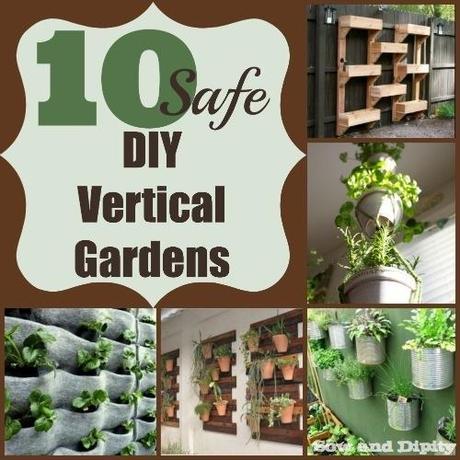
DIY Vertical Gardens- Are They Safe?
Growing ‘up’ is easy to do… unless your still a kid at heart like me (wink). If you have eyes bigger than your garden, then there are plenty of vertical garden ideas you could try but are they all safe?
Here’s a look at some of the many floating around on the internet and what you should consider before creating your own.
<A HREF="http://ws-na.amazon-adsystem.com/widgets/q?rt=tf_ssw&#038;ServiceVersion=20070822&#038;MarketPlace=CA&#038;ID=V20070822%2FCA%2Fsowanddip-20%2F8003%2F35bfedaf-ad2c-4d17-a517-6694b04d2bbf&#038;Operation=NoScript">Amazon.ca Widgets</A>#1 Pallet Garden
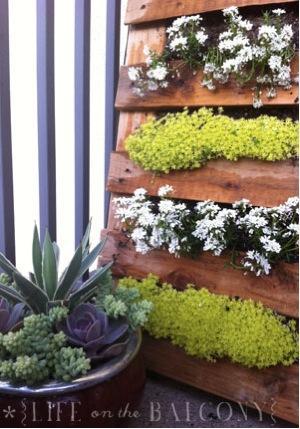
Pallet Garden by Life on the Balcony
Pallets are already heavy and once you add soil, plants and water, they weigh a ton! If you are going to plant directly into the pallet and mounting this to a wall, make sure it’s strong and secure. Leaning these against a wall is no problem unless your on a balcony with weight restrictions.
You can of course use the pallet as a vertical garden plant stand or ladder for container plants which they work great for… in a junkin’ garden kinda way. Fern from Life on the Balcony did a great job planting hers up with ornamental plants and Kelly show’s how you can combine a pallet with pots.
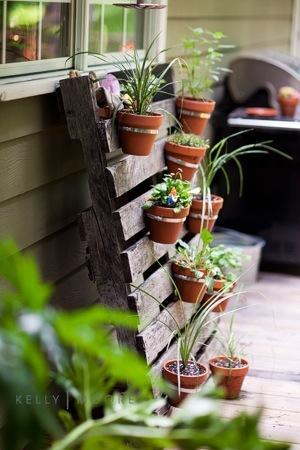
Pallet by Kelly Moore
Caution: Do you know where your pallet has been?
I have an issue with pallets being safe. If your planning on a flower garden or other non-edible plants, then go for it. But think twice about planting food like strawberries, herbs etc. Pallets are used to transport many different goods including toxic chemicals and are often made with treated wood for longevity.
Every time you water, those supposedly organic greens your growing absorb the leached toxins from that pallet. If you are simply using it like a ladder to hold pots of edibles, your in the clear.
#2 Fabric Plant Pockets
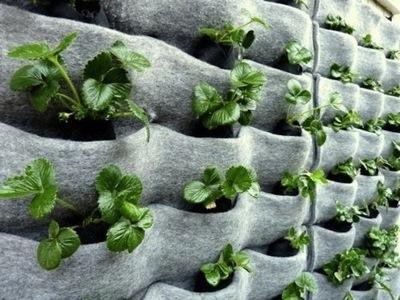
Florafelt by Plants on Walls
These are readily available in several types of fibers designed specifically for vertical garden growing purposes. You can grow a lot of food with one of these in a relatively small space and since they are made from natural fiber, they are good for the environment too.
Check out these recommended products for this type of growing:
Woolly Pocket
Plants on Walls Vertical Gardens
Vertical Eco Garden
In my last post I shared my DIY Plant Pockets made from recycled denim. If you are looking to create a fabric growing wall yourself, this material is a good option as it is made from breathable cotton, it can be customized to suit your needs… and you can add finishing touches that suit your style!
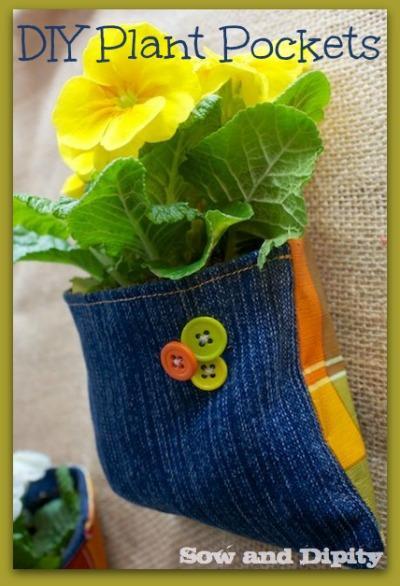
Caution: Is that Dollar Store Shoe holder safe?
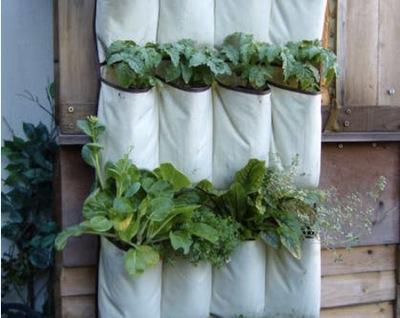
Yes and no. If you get one that is made of plastic, it most likely contains PCBs… a chemical commonly found in most plastics. I wouldn’t grow food in something like this, not only does it have the potential to leach when watered, but the suns UV rays slowly break down plastic further exaggerating the problem. Air is also important for healthy happy plants and the plastic shoe holders don’t allow for proper air circulation in such a small planting space.
However, there are muslin fabric shoe holders out there like the one above and these would definitely be fit for the task of creating your small space vertical garden.
#3 Gutter Gardens
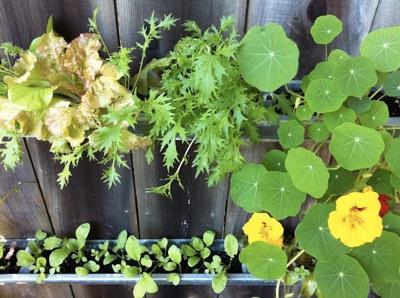
Gutter Garden By Corner Blog
These are pretty genius actually but the debate continues on aluminum, PVC, vinyl etc. being safe for food growing. Other things to consider is that they do dry out quickly so you have water often… I would think lining the back of the gutter with a soaker hose before you add soil would be a simple work around for this.
Caution: How old is your gutter?
If you are using a recycled gutter, you should have an idea how old it is because lead based paint was commonly used for exterior products including gutters until at least 1970. This would make that cool idea a huge don’t!
A galvanized steel gutter like what Tiffanie used above is perfect if you plan to grow food. If it’s just for pretty trailing annuals… then recycle away.
#4 PVC Pipe Gardening
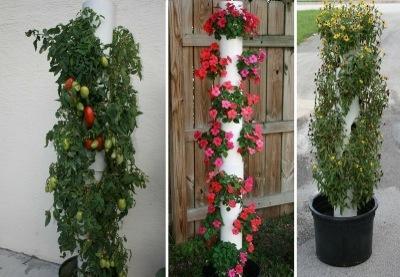
From OBN Network
Here’s another one that is debated tirelessly on the net. Is it safe? Well, yeah… pretty safe, where do you think that glass of water from the tap is coming from? There are plenty of articles to read on this and you’ll find that tests have shown there is little harm from the leaching. But don’t take my word for it, do some research and make an informed decision.
Caution: Not any old pipe will do.
Don’t try to recycle a pipe, buy new, then you can be sure no harmful substances ran through the pipe. PVC pipes work great when split in half and hung horizontally like gutter gardening or vertically with holes drilled out for strawberry towers. They are fairly inexpensive and readily available making these a good choice… and again, if it’s for an ornamental garden then you need not be concerned.
#5 Grow Bins and Bags
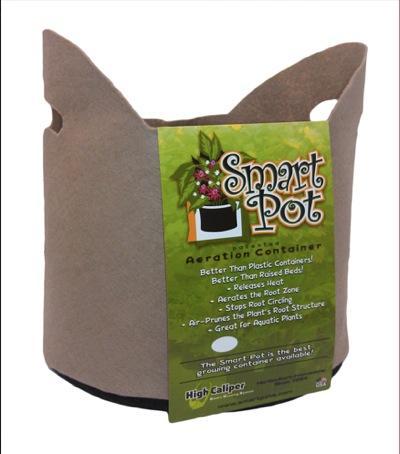
Fiber pot by Smart Pot
Grow bags are HUGE right now. Smart pot makes a great product not unlike the fiber wall pockets. It’s considered to be more of a container gardening technique but it can sort of cross over to a vertical garden concept as it isn’t an ‘in ground’ planting and it saves space by going ‘up’.
Caution: Will it hold up?
Cloth bags will break down pretty quickly unless they are made for the job. Recycled bags like the kind you get from the grocery store may not be sturdy enough for a full season and the bottom could rot out.
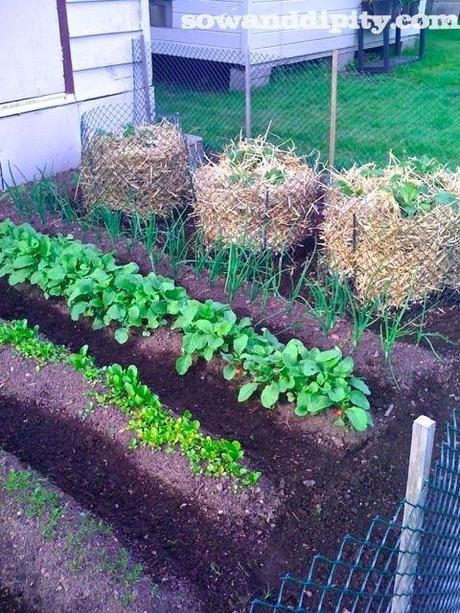
I grow my potatoes in mesh towers with straw to maximize the growing area in my veggie garden. Here’s my technique for a DIY Potato Tower.
#6 Plastic Bottles
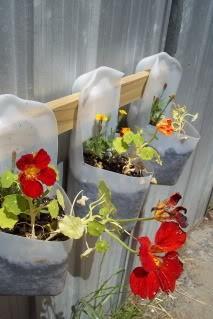
Upcycle Blog
Certain plastics are safe, others are not. Milk jugs for instance are rated an SPI #2 code (look on the triangle on the bottom) and therefore are said to be safe. Growing in these should be okay.
Caution: Recycled water or soda bottles are not!
You’ve heard about not drinking from a water bottle that was left in a hot car right? Well then why would you let it bake in the sun around your vegetables? If your not growing food, then fine… create any type of bottle garden you can imagine. But this girl won’t be growing edibles in those…ever.
#7 Tin Cans
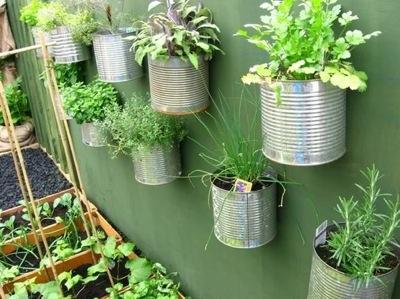
Now these are safe and can be hung vertically or mounted to a wall. They also come in all sizes so you can get really creative with them. I love the idea above for a clever vertical garden with a junkin’ style!
Caution: But do they last?
Well, no… they rust. However, replacing these after a season isn’t a big deal because you’ll always have more in the recycle bin.
#8 Glass and Terracotta
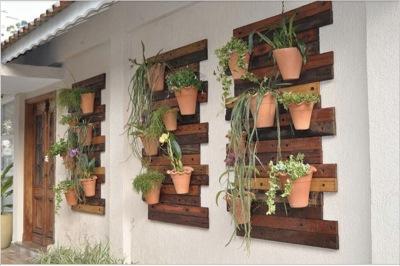
Wall Garden By Substrato
I love mason jars and lovely terracotta pots, not only are they aesthetically pleasing, they are completely safe. There is so many ways you can mount these vertically to walls or have them hanging in tiers.
Caution: Watering too much, Watering too little
Glass jars with no holes on the bottom need to be under a cover from an over hanging roof other wise a strong rain fall will have your pretty plants floating their way right out of their home. Terracotta on the other hand is very porous and can quickly dry out. These are really the only things to be concerned with.
I recently posted my DIY Macrame Plant Hanger for the Michaels / Hometalk Pinterest Party which I was proud to be a part of (only 4 bloggers in Canada were selected including yours truly… squee!) It’s easy to do and you can have your favorite herbs close at hand in this indoor vertical garden for the kitchen.
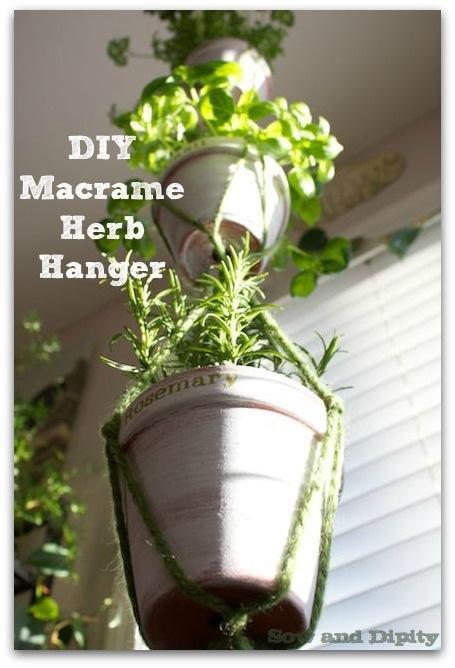
#9 Mesh Fencing and Netting
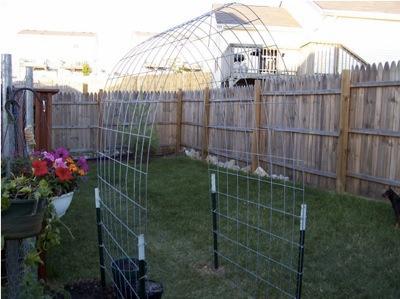
By Bencjedi on Gardenweb.com
This is the most standard way to grow vertically… training your veggies to climb! They don’t have to be vine types either, sprawling vegetables like squash and cucumbers can grow perfectly on a vertical support with a little training. I love the idea of using a cattle panel like the one above.
Caution: They’ll need your support.
If you plan on growing vegetables this way that have some weight ( like melons ), then you’ll need to make sure you cradle them once they begin to put on size and your support trellis, mesh or netting needs to be strong enough to hold all the weight of lots of fruit as the season wears on. Nylons (pantyhose) make great cradles for your growing veggies.
#10 Wood Planters
There is no end to the types of vertical gardens that can be created with this material. The only limit is your imagination. If need you design ideas, a quick Google search with deliver you a plethora of concepts, it really all comes down to how much space you have to build your vessel.
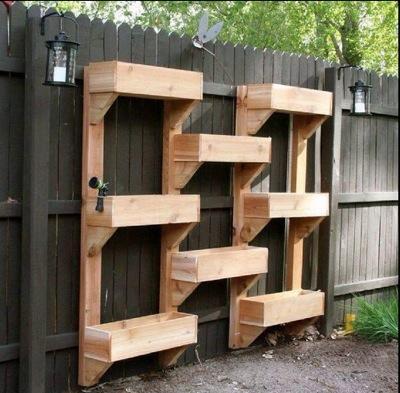
By OBN Network
Caution: Go Natural
NEVER plant your edibles in treated lumber. Landscape ties are the worst! The chemicals will leach every time you water. Untreated cedar is your best bet for longevity as it has its own natural preservatives. But wood is an organic material that will break down over time and will need to be replaced at some point.
So, there are some of the pro’s and con’s of 10 possible DIY Vertical Garden ideas you see floating around the internet for you to consider. Choosing what works for you depends on your space and budget, but don’t just opt to do something because it’s cheap and easy, not all ideas are good ones.
You need to decide first if this is for food or for aesthetics and select the best method that is both safe and functional for your small space garden requirements.
Have fun… growing up!
 Check out my Vertical Gardening Segment on Global Morning News
Follow Sow and Dipity on:

and

Peace Love Garden
In: Contained Beauty, Sowing By: Shelley Levis Comments: 6 « DIY Plant Pockets with Recycled Denim Spring Garden Inspirations »6 Responses to DIY Vertical Gardens – Are they all safe?
-
Tiffanie - March 9, 2014 at 6:53 pm - Reply →

Thank you for featuring my gutter garden here, Shelley. I really appreciate the angle you took here regarding food and environmental safety. Nice work!
-
karen@somewhatquirky - March 10, 2014 at 4:06 am - Reply →

I’m intrigued with the idea of growing tomatoes in the pvc pipe. I think this might help me get earlier tomatoes in Michigan by facilitating warmer dirt and more sun exposure. Hmmmmmmm
-
Christina - March 10, 2014 at 8:23 am - Reply →

How do you make holes in the pvc pipe and what should it look like for planting tomatoes or strawberries?
-
Shelley Levis - March 11, 2014 at 6:20 pm - Reply →

Follow the link on the bottom of the picture as it will take you to the instructions

-
-
Leanne - August 6, 2014 at 7:19 am - Reply →

Love this post! I’m going to be building something like this. Any advice on best designs for plants trying to survive harsh Canadian Prairie winters?
I have my strawberries in the ground currently but they are overrun with weeds. I am thinking of converting them to vertical and changing that bed over to a bee wildflower garden. However I’m not sure how these planters will work for freezing in the winter.
Thanks!
Leanne-
Shelley Levis - August 9, 2014 at 1:35 pm - Reply →

Hi Leanne, harsh winters cause havoc on all types of container planting since the likelihood of the roots freezing increase. I would probably stick to using most of these methods with quick growing flowering annuals and edibles in your case. Insulating larger containers is another method you can try for perennials, this requires using Styrofoam sheets around the edges inside the pot and burlap to wrap around the plants above the soil level. Research different ways to prep gardens for cold winters on the web, good luck!
-
Leave a Comment Cancel reply
Name*
Email* (never published)
Website
Give me more Garden Digs!
Notify me of follow-up comments by email.
Notify me of new posts by email.

